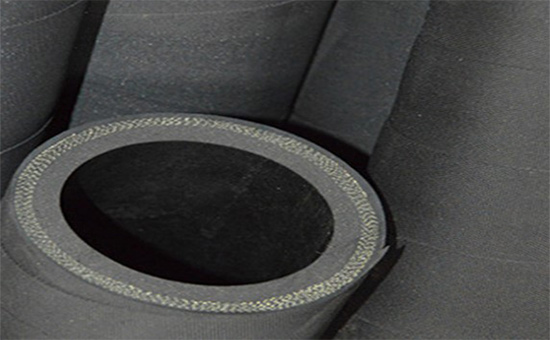
Heat-resistant hoses produced from butyl rubber or butyl reclaimed rubber have good air tightness and heat resistance. They can be used alone or in combination to produce hoses for steam or superheated water. The thermal performance requirement is particularly high; in the production process of butyl heat-resistant hose, the most relevant to the heat resistance of the rubber compound is the heat-resistant hose vulcanization system design, in addition to the quality of the butyl rubber and butyl reclaimed rubber. What is the best heat resistance of the butyl rubber/recycled vulcanizate after vulcanization?
At present, the vulcanization systems commonly used in the rubber products industry include ordinary sulfur vulcanization system, semi-effective vulcanization system, effective vulcanization system, peroxide vulcanization system and resin vulcanization system. The cross-linking structure formed by different vulcanization systems is different, and different cross-linking networks are different. The heat resistance of butyl rubber has different effects. The higher the bond energy, the better the heat resistance of vulcanizate. The chemical unsaturation of butyl rubber and butyl reclaimed rubber is low, and the polyisobutylene chain in the molecular structure is not active. Excellent heat resistance and oxidation resistance. The oxidative aging of butyl rubber after vulcanization is degradable. The rubber after aging tends to soften. Generally, phenolic resin and butyl rubber/recycled rubber which is vulcanized with p-benzoquinone Excellent heat resistance.
When butyl rubber and butyl reclaimed rubber are used to produce heat-resistant rubber hose, the most commonly used is alkyl phenolic resin, which forms a stable -C-C-crosslinking bond during vulcanization, has no vulcanization and anti-origin, has high thermal stability, and is resistant to vulcanized rubber. Good thermal performance, long life of butyl heat-resistant hose; 8-12 parts of p-tert-butylphenol formaldehyde resin as vulcanizing agent, with 1-4 parts of stannous chloride and 5-10 of neoprene as active The butyl rubber after vulcanization can withstand superheated water at 160 degrees Celsius; p-benzoquinone is particularly suitable as a vulcanizing agent for butyl rubber and butyl reclaimed rubber products, which is easy to disperse in the rubber compound during vulcanization and has a fast vulcanization speed. The vulcanized butyl rubber has high tensile strength and good heat resistance.
The effective system is a vulcanization system commonly used by rubber product manufacturers. The butyl rubber and butyl reclaimed rubber vulcanized by an effective vulcanization system form an absolutely dominant monosulfide bond and a disulfide bond, and the low sulfur is highly coordinated or not. When sulfur is compounded, the compound having 2 or 4 sulfur atoms in the molecular structure is used as a vulcanizing agent, and the amount is controlled to be 2.5-3.5 parts; when sulfur-free is combined, active sulfur can be released at a standard temperature, and the obtained butyl vulcanizate is resistant. Excellent thermal performance and small compression set; general butyl reclaimed rubber butyl rubber can be used in the production of heat-resistant hoses. The accelerator TT and the accelerator DTDM can be used. The vulcanized rubber has short cross-linking bonds, small compression deformation and low heat generation. High thermal stability.
In the actual production process, when butyl rubber/recycled rubber is used to produce heat-resistant hose, whether it is phenolic resin vulcanization, benzoquinone disulfide vulcanization or effective vulcanization system, rubber products manufacturers need to take into account the shortcomings when taking advantage of their advantages. For example, the vulcanized material after vulcanization of the effective vulcanization system has excellent resistance to thermal aging, but the vulcanization rate is slow, the fatigue property of the vulcanized rubber is poor, and it is easy to spray frost, so it is necessary to properly control the amount of various compounding agents in the vulcanization system.
The heat resistance of the butyl heat-resistant hose directly determines his maximum use temperature and time. It is the basis for ensuring that the heat-resistant hose can maintain normal performance for a long time. The factors affecting the heat resistance of the butyl rubber tube are also the type of filler and the anti-aging agent. Choice, etc., therefore, when using butyl rubber and butyl reclaimed rubber to produce heat-resistant hose, it is necessary to select high-quality rubber raw materials and design a reasonable heat-resistant hose formula. Especially when using butyl reclaimed rubber, it is necessary to calculate its own composition. Go in, and adjust the conditions of mastication, mixing time, temperature, etc., and use butyl reclaimed rubber as much as possible to reduce the cost of raw materials while ensuring the performance of the hose.
Exclusive original article [commercial authorization] reprint, excerpt and excerpt in any form are prohibited without written authorization. Focus on Hongyun rubber: learn the process formula and raw material technology of producing rubber products from recycled rubber to help you reduce costs and increase profits